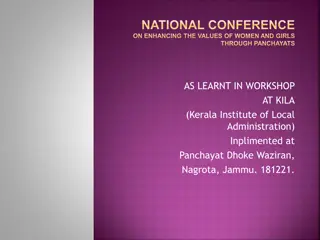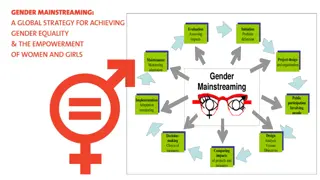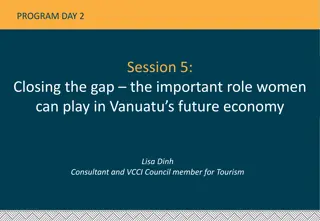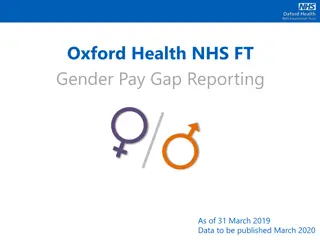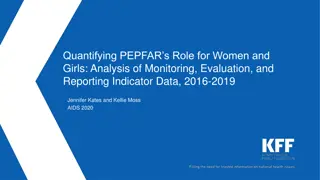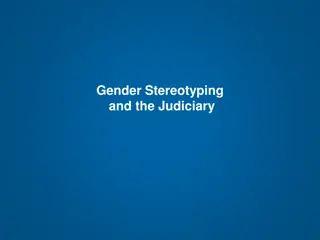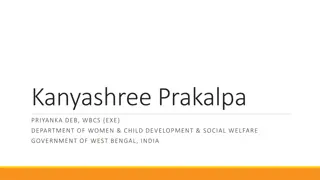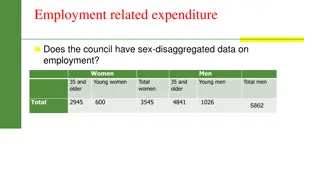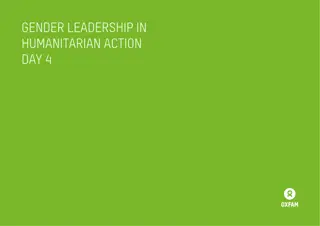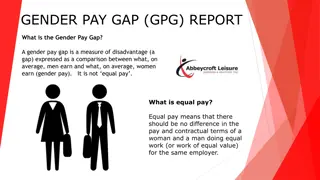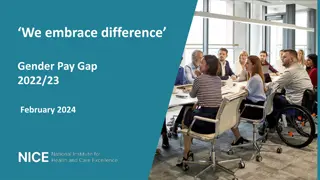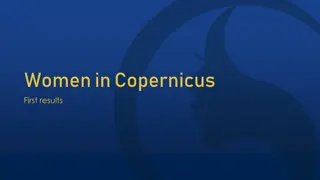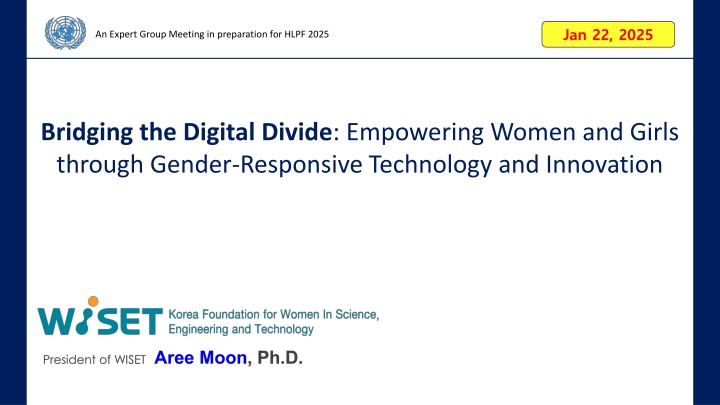
Bridging the Digital Gender Gap: Empowering Women and Girls through Technology
This session explores systemic barriers in technology to foster inclusion and equity, discussing recommendations for accelerating progress on SDG 5 and managing trade-offs across the 2030 Agenda. It also delves into the challenges of the digital gender divide, technological advancement, and gender inequality, highlighting the importance of empowering women and girls in the tech sector.
Download Presentation

Please find below an Image/Link to download the presentation.
The content on the website is provided AS IS for your information and personal use only. It may not be sold, licensed, or shared on other websites without obtaining consent from the author. If you encounter any issues during the download, it is possible that the publisher has removed the file from their server.
You are allowed to download the files provided on this website for personal or commercial use, subject to the condition that they are used lawfully. All files are the property of their respective owners.
The content on the website is provided AS IS for your information and personal use only. It may not be sold, licensed, or shared on other websites without obtaining consent from the author.
E N D
Presentation Transcript
Jan 22, 2025 An Expert Group Meeting in preparation for HLPF 2025 Bridging the Digital Divide: Empowering Women and Girls through Gender-Responsive Technology and Innovation President of WISET Aree Moon, Ph.D.
About this session Bridging the Digital Divide: Empowering Women and Girls through Gender-Responsive Technology and Innovation Addressing systemic barriers in technology to foster inclusion and equity Day/Time: 8:10 am 10:10 am (2h) , 22 January 2025 Overview: Discuss recommendations for accelerating progress on SDG 5, managing trade-offs and generating synergies across the 2030 Agenda Facilitator: Aree Moon, President, Korea Foundation for Women in Science, Engineering and Technology (WISET) 2
Participants 1. Reema Nanavaty, Self-Employed Women's Association (SEWA) 2. Isnawati Hidayah, Young Scientist Group World Food Forum; ROTASI Institute; Leiden University and Sapienza University of Rome (Online) 3. Catherine Ngila, African Foundation for Women & Youth in Education & STI 4. Laxman Belbase, MenEngage Alliance 5. Diane Ndarbawa, Association Pour une meilleure insertion socioprofessionnelle des filles et femmes du Cameroun (Online) 6. HRH Princess Dr. Nisreen El-Hashemite, Royal academy of Science International Trust (Online) 7. Albert Motivans, Equal Measures 2030 8. Eugenia McGill, Columbia University, School of International and Public Affairs 9. Kemi DaSilva-Ibru, Equality Now Africa 10. Timoth e Mac Dubois, Schneider Electric 11. Zara Rapoport, CARE (Online) 12. Antonia Kirkland, Equality Now 13. Madhavi Ariyabandu, Diryog Nivaran - South Asia Network for Disaster Mitigation (Online) 14. Claudia Flores, Working Group on Discrimination against Women and Girls (Online) 3
The Digital Gender Divide Women hold only 1 in 3 research positions worldwide In 2022, women comprised less than 25% of employees in STEM fields 15% of tech startup founders are women Only 17.7% of inventors named in international patents are women Over 70% of AI training data is male-centric The percentage of women in STEM-related fields in 2022 15% 17.7% 25% 33.3% 85% 82.3% 75% 66.7% Inventors in Patents Tech Startup Founders Research position Employees in STEM 4
Technological Advancement and Gender Inequality Emerging technologies like AI can reinforce biases against women and minorities. However, when used responsibly, they can address gender inequalities. Women are more likely to hold jobs at risk of AI replacement (3.7% female vs. 1.4% male employment) They have the Potential for widening inequalities 5
Challenges in Bridging the Digital Divide Lack of access to affordable and quality digital infrastructure Under-representation in education and professional fields related to STEM Structural Barriers Gender biases embedded in AI and digital systems that perpetuate inequality Insufficient gender-responsive policy frameworks in technology development Systemic Biases Women from marginalized communities face compounded barriers due to ethnicity, age, disability, and socio-economic status Intersectional Inequalities 6
Session Objectives Session Goals To showcase innovative, women-centered tech solutions for equality To highlight partnerships for scaling gender-responsive innovations To identify strategies for increasing women s leadership in STEM To explore policy frameworks to harness AI and tech for bridging inequalities Strategies for Increasing Women in STEM - Focus Areas Increasing participation of women in STEM fields Ensuring inclusion in design and decision-making phases of innovation 7
Guiding Qustions How can science, technology and innovation (STI) be used to address challenges specifically faced by women? What are some case studies of women-centered tech and innovation solutions? How can STI initiatives also address interlinkages and intersectionalities of exclusion related to gender, age, ability, ethnicity and others? What are some policies that help ensure resources are directed toward gender- responsive research and innovation? How can businesses, civil society, private sector, governments and other stakeholders create an enabling ecosystem for women s leadership and participation in STI? What policies or regulatory frameworks are needed so that technological change, such as the development of AI, bridges gaps and inequalities rather than leaving women and girls behind? And what are examples of AI being leveraged to close the gaps and inequalities? 8
Recommendations by Aree Moon 1. Expanding Access to Digital Education for Women and Girls 2. Leveraging Digital Technologies to Advance Women s Economic Empowerment 3. Improving Digital Literacy for Women of All Ages 4. Ensuring Access to Digital Devices and Internet Connectivity 5. Supporting Gender-Responsive Digital Technology Research and Development 6. Fostering Women's Leadership in Technology: Training, Mentorship, and Networking for Career Growth 7. AI-Driven Solutions for Combating Online Gender Discrimination 9
Discussion Bridging the Digital Divide: Empowering Women and Girls through Gender-Responsive Technology and Innovation
Participants 1. Reema Nanavaty, Self-Employed Women's Association (SEWA) 2. Isnawati Hidayah, Young Scientist Group World Food Forum; ROTASI Institute; Leiden University and Sapienza University of Rome (Online) 3. Catherine Ngila, African Foundation for Women & Youth in Education & STI 4. Laxman Belbase, MenEngage Alliance 5. Diane Ndarbawa, Association Pour une meilleure insertion socioprofessionnelle des filles et femmes du Cameroun (Online) 6. HRH Princess Dr. Nisreen El-Hashemite, Royal academy of Science International Trust (Online) 7. Albert Motivans, Equal Measures 2030 8. Eugenia McGill, Columbia University, School of International and Public Affairs 9. Kemi DaSilva-Ibru, Equality Now Africa 10. Timoth e Mac Dubois, Schneider Electric 11. Zara Rapoport, CARE (Online) 12. Antonia Kirkland, Equality Now 13. Madhavi Ariyabandu, Diryog Nivaran - South Asia Network for Disaster Mitigation (Online) 14. Claudia Flores, Working Group on Discrimination against Women and Girls (Online) 11


